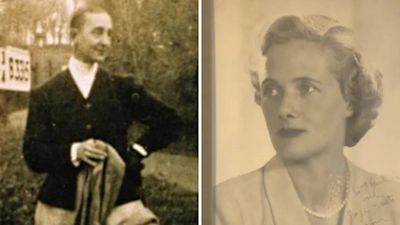Queer Kernow: The people from Cornwall's history you might not have heard of

Watch Charlotte Gay's report
A community group has been set up to show how LGBTQ+ people have lived and worked in Cornwall throughout history.
Queer Kernow has mapped out previously hidden or overlooked stories to show the legacy of queer history in Cornwall.
Co-Director Sophie Meyer says it is important they show these stories in rural communities.
"A lot of LGBTQ history is focus on the big cities, London, Manchester, Bristol, and I really found the community down here has been open to learning about rural lives and what happened in my local area."
Cornwall is always talked about for its beautiful landscapes and traditional ways of life, but Queer Kernow's other director Nicki Foley says they are hoping to educate people about other ways of life that have always been around.
She said: "It's just kind of like trying to educate people in normalising that there has always been an LGBT community even if it's in different aspects of history but they've always been around."
Daphne Du Maurier (1907-1989)
Du Maurier is a well-known and loved novelist who lived in Fowey and wrote stories inspired by the Cornish landscape but what is not discussed is her personal relationships with other women.
Sophie at Queer Kernow says letters unearthed after her death have revealed Du Maurier grappled with her sexual identity often referring in her letters to her heterosexual encounters as ‘Cairo’ and to homosexual encounters as ‘Venice’.
The only Daphne Du Maurier museum in the world is based at Jamaica Inn on Bodmin Moor but its owner says her sexuality is never brought up by their visitors.
Allen Jackson said: "It isn't discussed. I've spoken to one person in particular who has been on the door of the museum for maybe as long as two years and he says the subject has never come up - and that in itself is interesting."
Marlow Moss (1889-1958)
Moss changed her name from Majorie to Marlow in her twenties and subverted other gender norms by styling herself and her art in traditionally masculine ways.
She lived in with her life partner Netty Nijoff in Lamorna near Penzance for 17 years until her death in 1958.
Sally Noall, Interpretation Curator at Tate St Ives, says people who have researched her life say she was quite likely to have dropped the she/her pronouns and lived as non-binary.
"In all of Moss' letter she signed herself as Marlow or Marlow Moss and we also have some records of her partner Netty Nijoff talking about Moss as 'she'. So we certainly know Moss didn't present herself as a male but I do wonder given the era she lived in whether she may have preferred a pronoun of they if."
Piers Gaveston, 1st Earl of Cornwall (c.1284 – 1312)
King Edward II gave the first earldom of Cornwall to his favourite Piers Gaveston and some historians reading Medieval texts believe the pair were lovers.
Homosexuality was not illegal in this era of the middle ages but it is understood the favourism that was given to Gaveston caused much jealously among the earls of the time which ultimately lead to Gaveston’s beheading in 1312.
Modern historians have been divided over the subject. Some argue that the evidence for a same-sex relationship is indisputable, while others claim that Gaveston and the King were adoptive brothers.
Read more